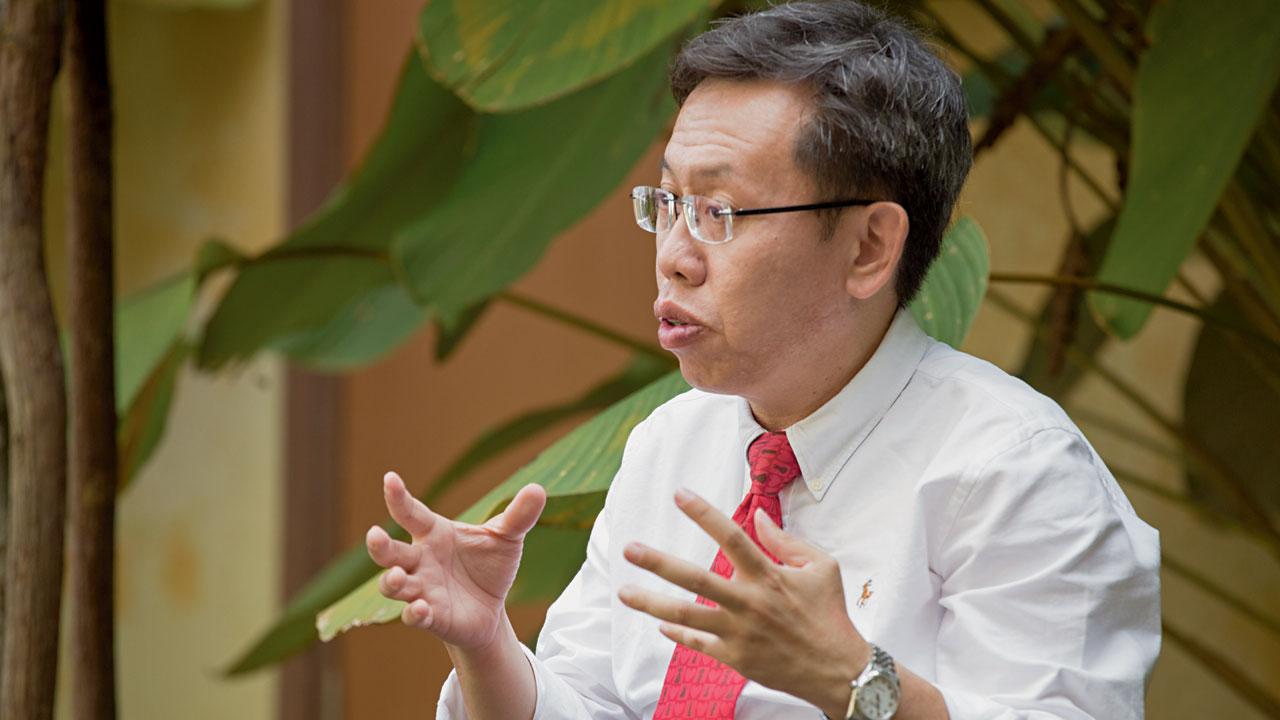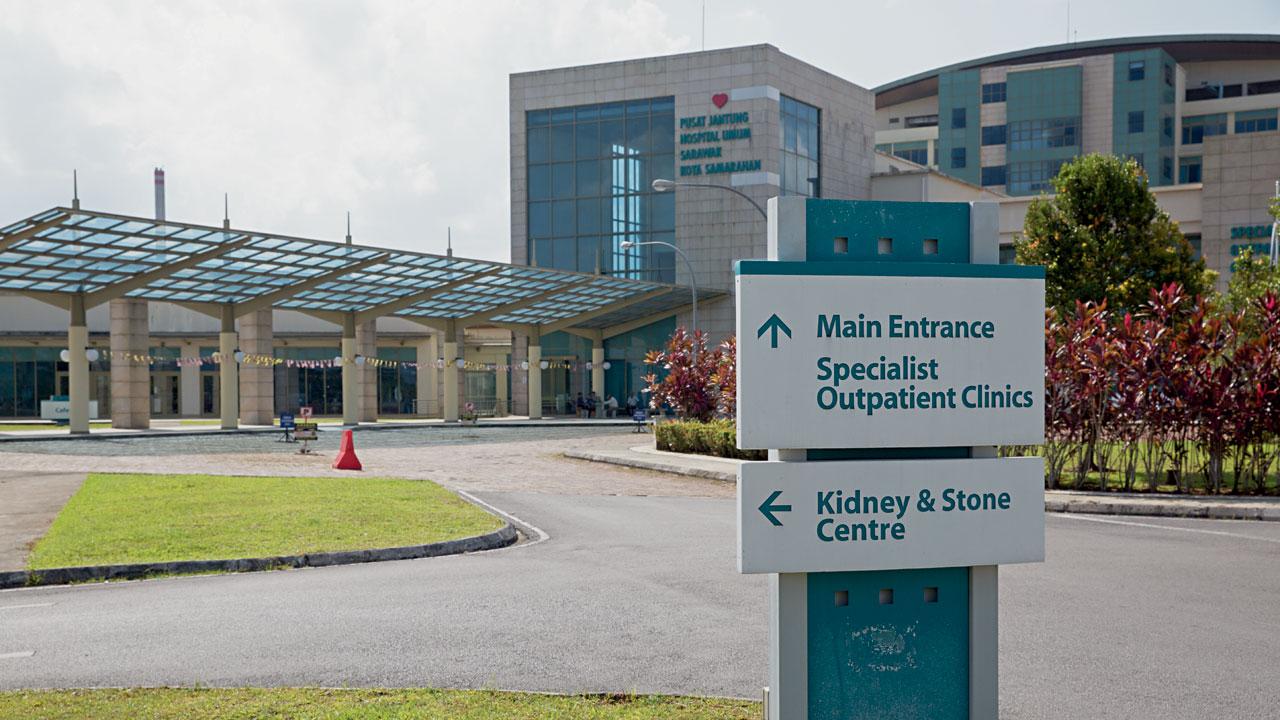Since its founding in 2001, the Sarawak General Hospital Heart Centre in Malaysia has become a renowned specialist healthcare and research facility. It offers excellent care at low cost. Two of its founders explain how grit, technology, and team spirit enabled this success.
Photos: Sebastian Forkarth
Management Summary
Challenge: Spread specialist cardiac care and promote quality for an aging population in an area with little access to healthcare.
Solution: Recognizing the benefits of embracing new technology, embarking on cutting-edge research, committing to patient equality.
Result: 15 to 20 (landmark) studies running at any one time, more than 20,000 patients on an outpatient basis, 800 angiographic procedures annually, and some 400 surgeries annually, including coronary artery bypass grafting, valvular repairs, and thoracic surgery.

The story of the Sarawak General Hospital Heart Centre began in 2001, when the Malaysian government recognized the need to spread specialist healthcare and promote quality for a burgeoning and aging population. “One must have the courage to lead,” says Professor Sim Kui-Hian, a distinguished interventional cardiologist who was one of the founding doctors of the Sarawak Heart Centre and today serves as a senator in the Malaysian parliament. According to Professor Sim, building a specialist hospital – in his words, “in the middle of the jungle!” – was as much an uphill task as an opportunity.
Challenging Rainforest
Sarawak is the largest state in Malaysia and lies in the northwest of tropical Borneo. Its population is made up of multiple indigenous tribes and immigrant groups spread across swathes of rainforest, some reachable only by air. In the past, no specialist cardiac institutions existed in Borneo, the biggest of the Asian islands. However, once the idea for the heart center materialized, it grew at an amazing pace. Early on, its doctors recognized the benefits of embracing new technology and cutting-edge research.

A Cardiac Center Evolves
In 2004, the facility became the first cardiac center in the country to offer cardiac magnetic resonance imaging. Cardiac computed tomography began in 2005, another first among Malaysia’s government-funded hospitals. Soon after, a research study was carried out to determine the reliability of cardiac CT in assessing coronary disease in individuals with calcium deposition in their coronary vessels. The study included 134 of the heart center’s patients, and the results were published in the American Heart Journal in 2006.1
Affordable Healthcare
Initially a division within the Department of Medicine at Sarawak General Hospital, the center relocated to a new building complex in 2011. The sheer force of modernity is evident throughout the center’s corridors. It offers state-of-the-art cardiac care at a cost envied by most developed nations. Each patient pays RM5 (less than US$2) per visit. This includes a medical consultation, laboratory tests, and medications. A diagnostic coronary angiography costs RM50 (around US$13), and percutaneous coronary intervention would cost RM400 (US$105).
Sarawak General Hospital Heart Centre – A Centre of Excellence

The Sarawak General Hospital Heart Centre is the only specialist cardiac hospital in the whole of Borneo. Located in the town of Kota Samarahan, about 30 kilometers from the capital city of Kuching in East Malaysia, it is the referral hospital for Sarawak, the largest state in the country. The population here is 2.5 million, and the people are spread over an area that is roughly the size of England and is interspersed with indomitable tropical rainforests.
The center offers many specialized healthcare services, including preventive cardiology, interventional cardiology, critical coronary care, pediatric cardiology, cardiac imaging, and cardiac and thoracic surgery. It currently serves more than 20,000 patients on an outpatient basis alone and performs about 800 angiographic procedures each year. The Cardiothoracic Surgery Unit performs some 400 surgeries annually. It offers a full range of surgical expertise, ranging from coronary artery bypass grafting to valvular repairs and thoracic surgery. The hospital complex houses 150 beds, including nine coronary care unit beds and nine coronary intensive care unit beds. It is staffed by about 600 doctors, nurses, technicians, radiographers, dieticians, physiotherapists, pharmacists, and social workers.
The center is housed within a modern building amid lush green surroundings in a quiet suburb. Behind the peaceful façade, though, expansion work in progress – it is almost a permanent fixture. Since the new building complex opened in 2011, the center’s caseload has been increasing non-stop, which is a testament to its importance in Sarawak’s healthcare system. It now receives patients from all over Borneo, and even from neighboring Brunei.
Kota Samarahan is dubbed the “city of knowledge” in Sarawak, as it is home to the state university and medical school. This provides a natural catalyst for the center to function as a nexus for medical training and education.
Although its primary task is to provide healthcare, the center has also become a leading research hospital in Malaysia. Its physicians and patients actively participate in international collaborative clinical trials, and its researchers have won numerous investigators’ awards over the years.

Equal Service for All
“Patients who come from isolated longhouses (a form of communal dwelling used by indigenous tribes and often lacking basic infrastructure), or vulnerable groups are all treated the same as the wealthy,” explains Dr. Ong. The center is unusual in that it makes no distinction between “first-class” and “second-class” rooms on its wards, unlike most Malaysian hospitals. This pledge to equality has certainly been a key to the center’s success.
Numerous Studies
Another key is its commitment to research, which has led to publications in prestigious medical journals that have broadcast local scientific talent to the rest of the world. For example, Professor Sim was a featured investigator in the multinational AVERROES study that involved a new anticoagulant for patients with atrial fibrillation. It comprised more than 5,000 patients across the world,2 and the results have helped to bring a new drug to the market. Similarly, the center recently participated in another landmark international collaboration designed to study the effects of a new medication for coronary artery disease.3
Healthcare in Malaysia

Since Malaysia gained independence from Britain in the mid-20th century, the government has recognized the need for investment in healthcare. It now channels almost five percent of gross domestic product into this critical sector.4
The investment has certainly paid off. The Malaysian healthcare system is two-tiered: there is a tax-funded, government-run universal healthcare system for the country’s 30 million people, and a rapidly growing private sector, especially in urban areas. The Malaysian Ministry of Health (MOH) is the main provider of health services.
Malaysians have a life expectancy of 75 years5 and the infant mortality rate stands at 7 (per 1,000 live births).6 This compares favorably with other developed nations. Like most countries, healthcare in Malaysia faces several challenges, such as rising costs, equal access, increasing quality demands, external economic pressure, changing lifestyles and demographics, and advances in technology. In response to these challenges, the MOH is reforming the healthcare system in collaboration with the private sector by transforming healthcare delivery and proactively identifying critical areas such as non-communicable diseases, among which cardiovascular disease is of the utmost importance. The idea is to expand preventive healthcare services while also investing in tertiary-level specialist care.

How to Boost Morale
Credit for all research projects is distributed equally among all investigators, regardless of their level of involvement. This has helped to boost morale, to create a sense of ownership, and to keep staff interested in research. “When we first started our clinical trials, it was difficult to motivate our colleagues to engage in research, as it is considered ‘extra-curricular’,” says Dr. Ong. “Then, after seeing the fruits of their work in publication, they couldn’t get enough of it!”
One Team – One Spirit
Today, the Sarawak Heart Centre regularly attracts cardiologists and technologists from as far away as Iran, hosting numerous workshops on cardiology and in particular cardiac CT. A large ornament in the shape of a heart greets all these visitors as they enter the reception hall. If they take a closer look, they will see that it is actually made up of many little hearts. “This has special meaning to us,” explains Professor Sim. “It symbolizes that this center is the result of everyone’s effort, and that it is for the benefit of everyone.”
About the Author
Ernie Yap is a medical writer and a physician specializing in internal medicine. After training in Canada and New York, he worked in private practice as a medical specialist in the U.S. before returning to his roots in Asia. His medical writing has featured in the South China Morning Post, Hong Kong.
